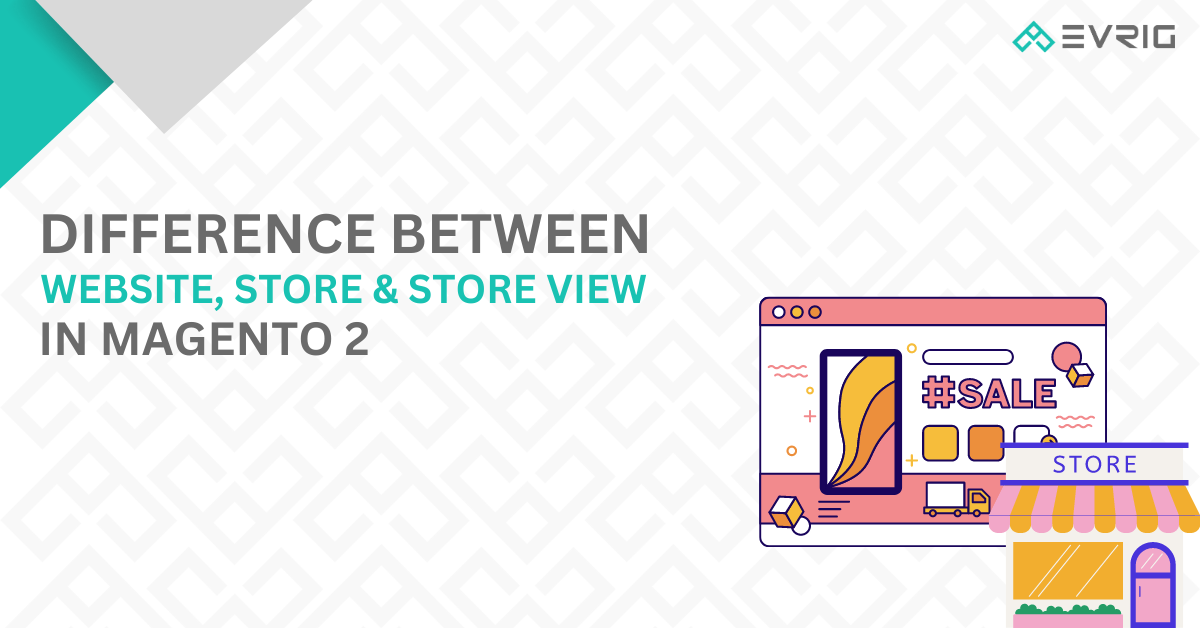Difference Between Website, Store & Store View In Magento 2
- July 7, 2023
- Category: Magento 2

Understanding the intricacies of Magento’s backend can be challenging for store owners, particularly when it comes to Magento 2 websites, stores, and store views. Differentiating between these components and configuring the backend accordingly can be confusing. However, this article simplifies the concepts and provides clear explanations of their differences and common use cases, ensuring that Magento store owners can comprehend them easily and without any unnecessary complexities.
What are Magento 2 Website, Store & Store View?
Magento 2 incorporates multiple scopes, namely website, store, and store views, to facilitate configuration changes.
The reason behind having these scopes is to enable store owners to establish distinct websites and variations of a single website within a unified backend.
This empowers businesses to deliver personalised experiences to diverse audiences, enhance the management of multiple stores, and seamlessly conduct international sales.
If you intend to create multiple websites or stores, leveraging these scopes proves immensely beneficial in simplifying the process.
Magento 2 Website, Store & Store View: the difference
Global
The global scope is the highest level in the hierarchy and encompasses the broadest range. When setting up a new Magento website without any previous configurations, the out-of-the-box settings correspond to the global view’s settings.
On a global scale, there are three setting options available:
Stock settings: Managing stock options applies universally to all stores and websites.
Price: You can set the same price for all websites and stores.
Customer data: Customer data from various websites and stores can be consolidated into a single comprehensive database.
Modifying the global settings impacts all stores and websites simultaneously. It’s important to note that the Magento backend supports only one global view, which cannot be duplicated or removed.
Website:
Upon installation, Magento 2 provides a default website known as the main website. However, users have the flexibility to add additional websites with unique IP addresses and domains. For instance, they can create websites like cat.com and dog.com. This feature allows for the establishment of multiple websites with distinct identities within the Magento 2 platform.
Configurable Elements within the Magento “Website” Scope
In contrast to the global scope, the website view does not allow for changing stock options. This implies that all websites within Magento share the same inventory and inventory configurations. Nonetheless, the website scope provides the ability to configure more intricate settings compared to its parent scope, the global scope. This includes the capability to create distinct payment and shipping methods for each individual website.
Use Cases of Having Multiple Websites in Magento
If you are considering setting up multiple websites within your Magento backend, there are several scenarios where this approach is beneficial:
- Brand differentiation: If you have multiple brands with distinct domain addresses, creating separate websites allows you to maintain unique identities for each brand.
- Targeting different customer groups: If you cater to diverse customer groups, such as B2B and B2C, separating them within different websites enables effective data gathering, marketing optimization, and customised pricing for each group.
- Product-specific requirements: When selling different types of products, such as seed milk and fashion items, having separate websites allows you to implement specific payment methods (e.g., subscription or one-click checkout) and delivery options tailored to each product category.
- International selling: For businesses operating internationally, multiple websites facilitate optimization of shipment methods, payment methods, base currency, and tax classes to cater to the specific needs of customers in different countries.
Store:
Within a website, a store represents a container for products, categories, and other configuration settings. Multiple stores can be created under a website, each with its own unique settings and characteristics. Here’s what you need to know about stores:
- Products and Categories: Each store has its own set of products and categories. This allows you to organize your product catalog differently for each store, catering to different target audiences or product lines.
- Store-Specific Configurations: Store-specific settings can be defined at the store level. These include store name, logo, email addresses, and more. Customizing these settings enables you to provide a distinct brand experience for each store.
- Separate Pricing: One of the key advantages of stores is the ability to set different pricing for products. This is particularly useful when you have multiple stores targeting different customer segments or regions.
- Independent Inventory: Unlike websites, stores have separate inventory management. You can track stock quantities and manage product availability at the store level, ensuring accurate inventory management for each store.
- Different Storefronts: Each store can have its own unique storefront design, allowing you to create visually distinct shopping experiences for customers across different stores.
Store View:
At the lowest level of the hierarchy, a store view represents a specific view or presentation of a store. It determines the language, currency, and other locale-specific settings visible to the customers. Here are the key aspects of store views:
- Localization: Store views are primarily used for localization purposes. You can create multiple store views within a store to cater to customers speaking different languages or residing in different regions.
- Language and Currency: Each store view can have its own language and currency settings, providing a personalized experience to customers based on their preferred language and currency.
- SEO Benefits: Store views play a vital role in search engine optimization (SEO) efforts. Having store views specific to different languages or regions allows search engines to index and display the most relevant content to users.
- URL Structure: Store views can be associated with specific URLs, enabling customers to access the store in their preferred language or region directly.
- Shared Catalog and Inventory: Store views within the same store share the same catalog and inventory. This means that product availability and pricing remain consistent across store views within a store.